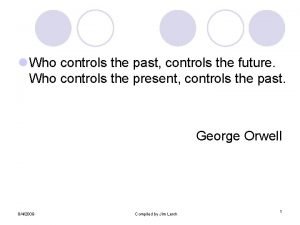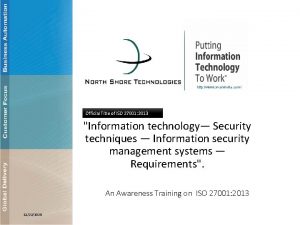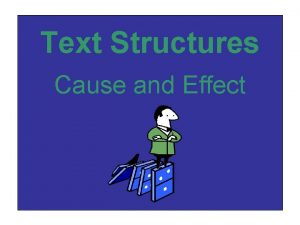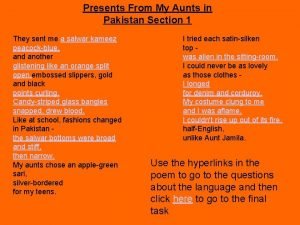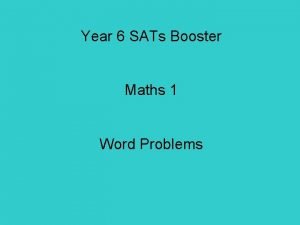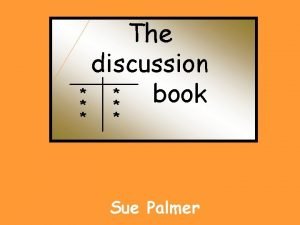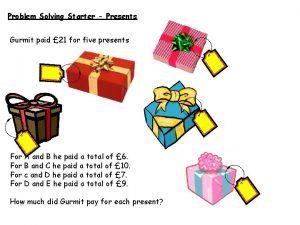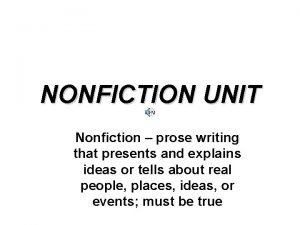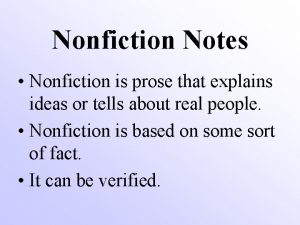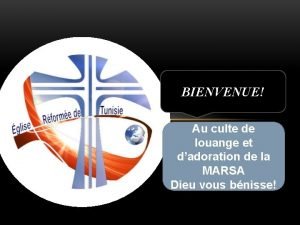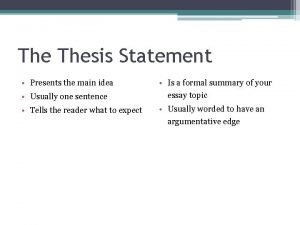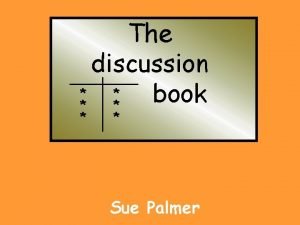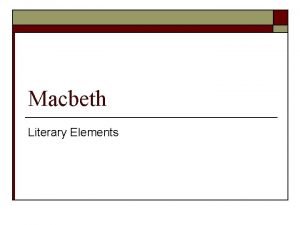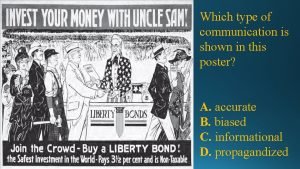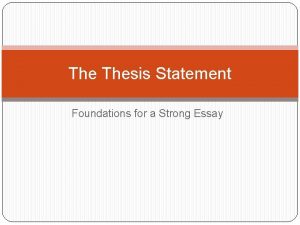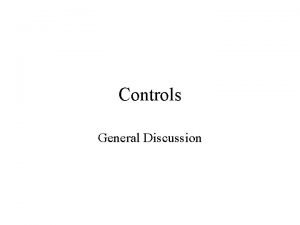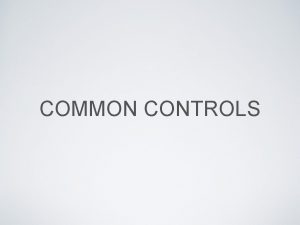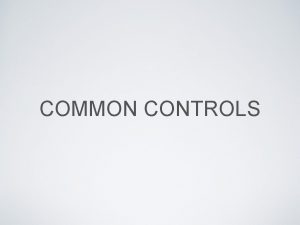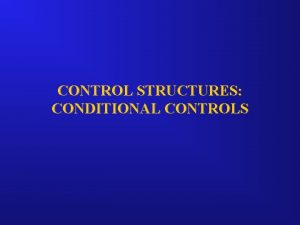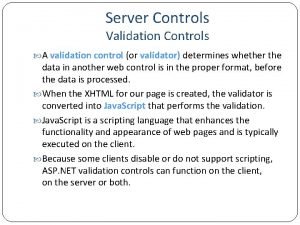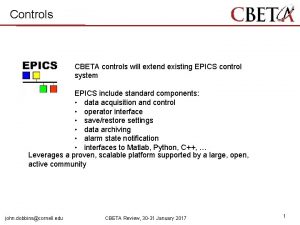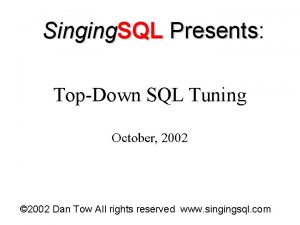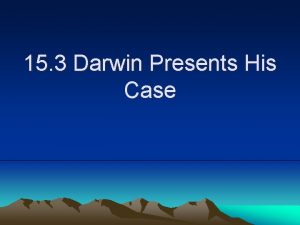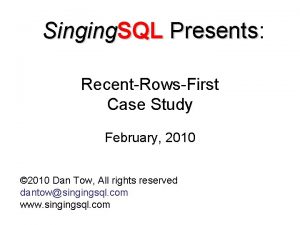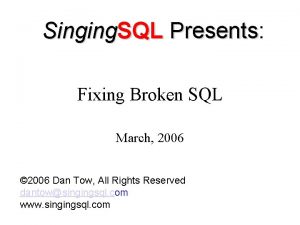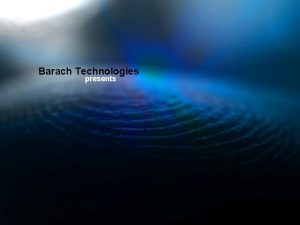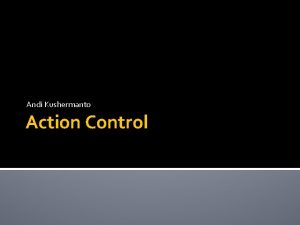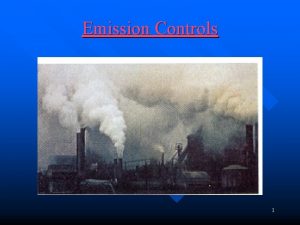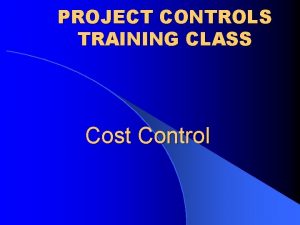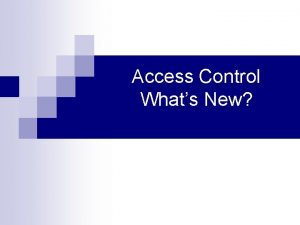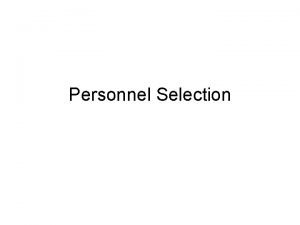Selection Controls Selection Controls A selection control presents































- Slides: 31

Selection Controls

Selection Controls • A selection control presents on the screen used to select possible alternatives, conditions, or choices, or value. • The relevant item or items are selected from those displayed. • Some selection controls present all the alternatives together, visibly on a screen; others may require an action to retrieve the entire listing and/ or scrolling to view all the alternatives. • Selection controls include radio buttons, check boxes, list boxes, drop-down/pop-up list boxes, and palettes.

Selection Controls • • • • Radio Buttons ■ Description: — A two-part control consisting of the following: • Small circles, diamonds, or rectangles. • Choice descriptions. — When a choice is selected: • The option is highlighted. • Any existing choice is automatically unhighlighted and deselected. ■ Purpose: — To set one item from a small set of mutually exclusive options (2 to 8). ■ Advantages: — Easy-to-access choices. — Easy-to-compare choices. — Preferred by users.

Selection Controls • • • • Check Boxes ■ Description: — A two-part control consisting of a square box and choice description. — Each option acts as a switch and can be either “on” or “off. ” • When an option is selected (on), a mark such as an “X” or “check” appears within the square box, or the box is highlighted in some other manner. • Otherwise the square box is unselected or empty (off). — Each box can be: • Switched on or off independently. • Used alone or grouped in sets. Purpose: — To set one or more options as either on or off. ■ Advantages — Easy-to-access choices. — Easy-to-compare choices. — Preferred by users.

Selection Controls • • • Palettes ■ Description: — A control consisting of a series of graphical alternatives. The choices themselves are descriptive, being composed of colors, patterns, or images. — In addition to being a standard screen control, a palette may also be presented on a pull-down or pop-up menu or a toolbar. ■ Purpose: — To set one of a series of mutually exclusive options presented graphically or pictorially. ■ Advantages: — Pictures aid comprehension. — Easy-to-compare choices. — Usually consume less screen space than textual equivalents.

Selection Controls • • • • • List Boxes ■ Description: — A permanently displayed box-shaped control containing a list of attributes or objects from which: • A single selection is made (mutually exclusive), or • Multiple selections are made (non-mutually-exclusive). — The choice may be text, pictorial representations, or graphics. — Selections are made by using a mouse to point and click. — Capable of being scrolled to view large lists of choices. — No text entry field exists in which to type text. — A list box may be associated with a summary list box control, which allows the selected choice to be displayed or an item added to the list. ■ Purpose: — To display a collection of items containing: • Mutually exclusive options. • Non-mutually-exclusive options. ■ Advantages: — Unlimited number of choices. — Reminds users of available options. — Box always visible.

Selection Controls • List View Controls • ■ Description: • — A special extended-selection list box that displays a collection of items, consisting of an icon and a label. • — The contents can be displayed in four different views: • • Large Icon: Items appear as a full-sized icon with a label below. • • Small Icon: Items appear as a small icon with label to the right. • • List: Items appear as a small icon with label to the right. • — Arrayed in a columnar, sorted layout. • • Report: Items appear as a line in a multicolumn format. • — Leftmost column includes icon and its label. • — Subsequent columns include application-specific information. • ■ Purpose and usage: • — Where the representation of objects as icons is appropriate. • — To represent items with multiple columns of information.

Selection Controls • Drop-down/Pop-up List Boxes • ■ Description • — A single rectangular control that shows one item with a small button to the right side. • • The button provides a visual cue that an associated selection box is available but hidden. • — When the button is selected, a larger associated box appears, containing a list of choices from which one may be selected. • — Selections are made by using the mouse to point and click. • — Text may not be typed into the control. • ■ Purpose: • — To select one item from a large list of mutually exclusive options when screen space is limited. • ■ Advantages: • — Unlimited number of choices. • — Reminds users of available options. • — Conserves screen space.

Combination Controls

Combination Controls • It is possible for a control to possess the characteristics of both a text field and a selection field. • In this type of control, information may either be keyed into the field or selected and placed within it. • The types of combination entry/selection fields are spin boxes, attached combination boxes, and drop-down/pop-up combination boxes.

Combination Controls • Spin Boxes • ■ Description: • — A single-line field followed by two small, vertically arranged buttons. • • The top button has an arrow pointing up. • • The bottom button has an arrow pointing down. • — Selection/entry is made by: • • Using the mouse to point at one of the directional buttons and clicking. Items will change by one unit or step with each click. • • Keying a value directly into the field itself. • Purpose: • — To make a selection by either scrolling through a small set of meaningful predefined choices or typing text. • ■ Advantages: • — Consumes little screen space. • — Flexible, permitting selection or typed entry.

Combination Controls • • • • Combo Boxes ■ Description: — A single rectangular text box entry field, beneath which is a larger rectangular list box (resembling a drop-down list box) displaying a list of options. — The text box permits a choice to be keyed within it. — The larger box contains a list of mutually exclusive choices from which one may be selected for placement in the entry field. • Selections are made by using a mouse to point and click. — As text is typed into the text box, the list scrolls to the nearest match. — When an item in the list box is selected, it is placed into the text box, replacing the existing content. — Information keyed may not necessarily have to match the list items. ■ Purpose: — To allow either typed entry in a text box or selection from a list of options in a permanently displayed list box attached to the text box. ■ Advantages: — Unlimited number of entries and choices. — Reminds users of available options. — Flexible, permitting selection or typed entry.

Combination Controls • Drop-down/Pop-up Combo Boxes • ■ Description: • — A single rectangular text box with a small button to the side and an associated hidden list of options. • • The button provides a visual cue that an associated selection box is available but hidden. • — When requested, a larger associated rectangular box appears, containing a scrollable list of choices from which one is selected. • — Selections are made by using the mouse to point and click. • — Information may also be keyed into the field. • — As text is typed into the text box, the list scrolls to the nearest match. • — When an item in the list box is selected, it is placed into the text box, replacing the existing content. • — The information keyed does not necessarily have to match list items. • — Combines the capabilities of both a text box and a drop-down/pop-up list box.

Combination Controls • • • • • • • • Drop-down/Pop-up Combo Boxes — To allow either typed entry or selection from a list of options in a list box that may be closed and retrieved as needed. ■ Advantages: — Unlimited number of entries and choices. — Reminds users of available options. — Flexible, permitting selection or typed entry. — Entries not restricted to items selectable from list box. — Conserves screen space. ■ Disadvantages: — Requires an extra step to display the list of choices. — When displayed, all box choices may not always be visible, requiring scrolling. — User may have difficulty in recalling what to type. — The list content may change, making it hard to find items. — The list may be ordered in an unpredictable way, making it hard to find items. ■ Proper usage: — For entering or selecting objects or values or setting attributes. — For information that is mutually exclusive (only one can be entered or selected). — When users may find it practical to, or prefer to, type information rather than selecting it from a list. — When users can recall and type information faster than selecting from a list. — When it is useful to provide the users with an occasional reminder of the choices available. — Where data must be entered that is not contained in the selection list. — Where screen space is limited. — For data and choices that are: • Best represented textually. • Somewhat familiar or known. • Ordered in an unpredictable fashion. • Frequently changed. • Large in number. • Variable or fixed in list length.

Custom Controls

Custom Controls • Implement custom controls with caution. • If used, make the look and behavior of custom controls different from that of standard controls. • Many toolkits and interface builders provide the ability to create custom controls; implement them with caution. • The user is currently presented with a multitude of controls whose usage and operation must be learned and remembered.

Custom Controls • The addition of custom controls adds to this learning and increases system complexity. • If custom controls must be developed and implemented, make their look and behavior as different as possible from the standard controls. • This will avoid confusion between the various controls.

Presentation Controls

Presentation Controls • Presentation controls are purely informational. • They provide details about other screen elements or controls, or assist in giving the screen structure. • Common presentation controls are static text fields, group boxes column headings, Tool. Tips, balloon tips, and progress indicators.

Presentation Controls • • • Static Text Fields ■ Description: — Read-only textual information. ■ Purpose: — To identify a control by displaying a control caption. — To clarify a screen by providing instructional or prompting information. — To present descriptive information. ■ Proper usage: — To display a control caption. — To display instructional or prompting information. — To display descriptive information.

Presentation Controls • • • • Group Boxes ■ Description: — A rectangular frame that surrounds a control or group of controls. — An optional caption may be included in the frame’s upper-left corner. ■ Purpose: — To visually relate the elements of a control. — To visually relate a group of related controls. ■ Proper usage: — To provide a border around radio button or check box controls. — To provide a border around two or more functionally related controls. ■ Guidelines: — Label or heading: • Typically, use a noun or noun phrase for the label or heading. • Provide a brief label or heading, preferably one or two words.

Presentation Controls • Column Headings • ■ Description: • — Read-only textual information that serves as a heading above columns of text or numbers. • — Can be divided into two or more parts. • ■ Purpose: • — To identify a column of information contained in a table. • ■ Proper usage: • — To display a heading above a column of information contained in a table. • ■ Guidelines: • — Heading: • • Provide a brief heading. • • Can include text and a graphic image. • • Capitalize the first letter of each significant word. • • Do not include an ending colon ( : ). • — The width of the column should fit the average size of the column entries. • — Does not support keyboard access.

Presentation Controls • • • • • Tool. Tips ■ Description: — A small pop-up window containing descriptive text that appears when a pointer is moved over a control or element either: • Not possessing a label. • In need of additional descriptive or status information. ■ Purpose: — To provide descriptive information about a control or screen element. ■ Advantages: — Identifies an otherwise unidentified control. — Reduces possible screen clutter caused by control captions and descriptive information. — Enables control size to be reduced. ■ Disadvantages: — Not obvious, must be discovered. — Inadvertent appearance can be distracting. ■ Proper usage: — To identify a control that has no caption. — To provide additional descriptive or status information about a screen element.

Presentation Controls • • • • • • Balloon Tips ■ Description: — A small pop-up window that contains information in a word balloon. — Components can include: • Title. • Body text. • Message Icons. — Appear adjacent to the item to which they apply, generally above or to left. — Only one tip, the last posted, is visible at any time. — Tips are removed after a specified time period. ■ Purpose: — To provide additional descriptive or status information about a screen element. ■ Advantages: — Provides useful reminder and status information. ■ Disadvantages: — If overused they lose their attention-getting value. — If overused in situations the user considers not very important, their continual appearance can be aggravating. ■ Proper usage: — To display noncritical: • Reminder information. • Notification information. — Do not use tips to display critical information.

Presentation Controls • Progress Indicators • ■ Description: • — A rectangular bar that fills as a process is being performed, indicating the percentage of the process that has been completed. • ■ Purpose: • — To provide feedback concerning the completion of a lengthy operation. • ■ Proper usage: • — To provide an indication of the proportion of a process completed. • A progress indicator is a rectangular bar that fills as a process is being performed. • The filled-in area indicates the percentage of a process that has been completed. • A progress indicator, sometimes called a progress bar, is illustrated in Figure 7. 89.

Presentation Controls • Sample Box • ■ Description: • — A box illustrating what will show up on the screen based upon the parameter or parameters selected. • — May include text, graphics, or both. • ■ Purpose: • — To provide a representation of actual screen content based upon the parameter or parameters selected. • ■ Guidelines: • — Include a brief label. • — Use mixed case in the headline style. • — Locate it adjacent to the controls upon which it is dependent. • Description. • A sample box is a box illustrating what will show up on the screen based upon the parameter or parameters currently selected.

Presentation Controls Scrolling Tickers ■ Description: — Text that scrolls horizontally through a container window. ■ Advantages: — Consume less screen space than full text. ■ Disadvantages: — Hard to read. — Time-consuming to interpret. — Distracting. ■ Guideline: — Do not use. Description. A scrolling ticker is a window that contains text scrolling horizontally. • Advantages/disadvantages. The biggest advantage of a scrolling ticker is its efficient use of screen space. • • •

Presentation Controls

Presentation Controls

Presentation Controls

Presentation Controls
 General controls vs application controls
General controls vs application controls He who controls the past controls the future
He who controls the past controls the future Environmental controls infection control
Environmental controls infection control Iso 27001 domains, control objectives and controls
Iso 27001 domains, control objectives and controls Cause and effect text structure definition
Cause and effect text structure definition Presents from my aunts in pakistan
Presents from my aunts in pakistan Pear paragraphs
Pear paragraphs Sally elatta presents on business agility
Sally elatta presents on business agility 16 3 darwin presents his case answer key
16 3 darwin presents his case answer key Section 15–3 darwin presents his case
Section 15–3 darwin presents his case Zids and zods
Zids and zods A text that presents one side of the topic
A text that presents one side of the topic Zids and zods
Zids and zods Prose writing that presents and explains ideas
Prose writing that presents and explains ideas Prose writing that presents and explains ideas
Prose writing that presents and explains ideas Gurmit paid £21 for five presents
Gurmit paid £21 for five presents Shona quiz
Shona quiz Pour cet immense bonheur alléluia
Pour cet immense bonheur alléluia Which statement presents the main idea of the text
Which statement presents the main idea of the text A 26 year old female presents
A 26 year old female presents This presents
This presents What is a tragedy
What is a tragedy Structure in drama
Structure in drama Sue palmer discussion book
Sue palmer discussion book Shcedules
Shcedules Tragedy
Tragedy Which type of communication is shown in this poster?
Which type of communication is shown in this poster? A thesis statement presents
A thesis statement presents Which sentence presents a faulty either/or argument?
Which sentence presents a faulty either/or argument? Chapter 17 neurologic emergencies
Chapter 17 neurologic emergencies Balancing selection vs stabilizing selection
Balancing selection vs stabilizing selection Similarities
Similarities

